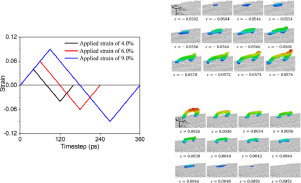当前位置:
X-MOL 学术
›
Acta Mater.
›
论文详情
Our official English website, www.x-mol.net, welcomes your feedback! (Note: you will need to create a separate account there.)
Dislocation nucleation and evolution at the ferrite-cementite interface under cyclic loadings
Acta Materialia ( IF 9.4 ) Pub Date : 2020-03-01 , DOI: 10.1016/j.actamat.2019.12.052 Lun-Wei Liang , Yun-Jiang Wang , Yan Chen , Hai-Ying Wang , Lan-Hong Dai
Acta Materialia ( IF 9.4 ) Pub Date : 2020-03-01 , DOI: 10.1016/j.actamat.2019.12.052 Lun-Wei Liang , Yun-Jiang Wang , Yan Chen , Hai-Ying Wang , Lan-Hong Dai

|
Abstract Fatigue is of significant importance to the engineering applications of the structural materials. High-strength pearlite steel consisting of a ductile ferrite phase and a brittle cementite phase is a widely used structural metal for extreme load-bearing applications. However, the fatigue mechanisms of such important materials remain elusive, in particular, the atomic-scale dislocation behaviors at interface are poorly understood. We used molecular dynamics simulations to probe the mechanical response and deformation mechanism of the Bagaryatskii-oriented ferrite-cementite interface in pearlite. The interface was subjected to a hundred symmetric tension-compression deformation cycles. Three different loading schemes with strain magnitudes of 4.0%, 6.0%, and 9.0% are sophisticatedly designed to explore the cyclic plastic mechanisms under different conditions corresponding to pure elasticity, elasticity in tension but plasticity in compression, and plasticity in both tension and compression, respectively. During cyclic deformation, rapid dislocation accumulation occurs in the first 30 cycles, after which dislocation density decreases to a stable value in ferrite. It is found that the onset of plasticity is governed by dislocation nucleation from the ferrite-cementite interface. After slip into the ferrite phase, some dislocations annihilate at the interface. After a few tens of cycles, the dislocation nucleation and annihilation rates become equal, leading to a steady-state flow in cyclic deformation. Up to high cycles with large strain magnitude, the magnitude of plastic strain in pearlite is higher than critical values and slip crosses the interface from the ferrite phase to the brittle cementite phase. Dislocation slip in cementite will destroy the interface structure, which may be the plastic mechanism of final fatigue failure. Our simulations agree with experimental observations of dislocation evolution in the ratchetting of pearlitic steels and provide further atomic-scale mechanisms to explain the fatigue failure of these materials.
中文翻译:

循环载荷作用下铁素体-渗碳体界面位错成核与演化
摘要 疲劳对结构材料的工程应用具有重要意义。由韧性铁素体相和脆性渗碳体相组成的高强度珠光体钢是一种广泛用于极端承载应用的结构金属。然而,这些重要材料的疲劳机制仍然难以捉摸,特别是界面处的原子级位错行为知之甚少。我们使用分子动力学模拟来探讨珠光体中 Bagaryatskii 取向的铁素体-渗碳体界面的机械响应和变形机制。界面经受了一百次对称的拉伸-压缩变形循环。三种不同的加载方案,应变大小分别为 4.0%、6.0% 和 9。0% 是精心设计的,用于探索不同条件下的循环塑性机制,分别对应于纯弹性、拉伸弹性但压缩塑性以及拉伸和压缩塑性。在循环变形过程中,在前 30 个循环中发生快速位错积累,之后位错密度在铁素体中下降到稳定值。发现塑性的开始是由铁素体-渗碳体界面的位错成核控制的。滑入铁素体相后,一些位错在界面处湮灭。经过几十次循环后,位错成核率和湮没率变得相等,导致循环变形中的稳态流动。高达大应变幅度的高循环,珠光体中塑性应变的大小高于临界值并且滑移穿过从铁素体相到脆性渗碳体相的界面。渗碳体中的位错滑移会破坏界面结构,这可能是最终疲劳失效的塑性机制。我们的模拟与珠光体钢棘轮作用中位错演化的实验观察结果一致,并提供了进一步的原子尺度机制来解释这些材料的疲劳失效。
更新日期:2020-03-01
中文翻译:

循环载荷作用下铁素体-渗碳体界面位错成核与演化
摘要 疲劳对结构材料的工程应用具有重要意义。由韧性铁素体相和脆性渗碳体相组成的高强度珠光体钢是一种广泛用于极端承载应用的结构金属。然而,这些重要材料的疲劳机制仍然难以捉摸,特别是界面处的原子级位错行为知之甚少。我们使用分子动力学模拟来探讨珠光体中 Bagaryatskii 取向的铁素体-渗碳体界面的机械响应和变形机制。界面经受了一百次对称的拉伸-压缩变形循环。三种不同的加载方案,应变大小分别为 4.0%、6.0% 和 9。0% 是精心设计的,用于探索不同条件下的循环塑性机制,分别对应于纯弹性、拉伸弹性但压缩塑性以及拉伸和压缩塑性。在循环变形过程中,在前 30 个循环中发生快速位错积累,之后位错密度在铁素体中下降到稳定值。发现塑性的开始是由铁素体-渗碳体界面的位错成核控制的。滑入铁素体相后,一些位错在界面处湮灭。经过几十次循环后,位错成核率和湮没率变得相等,导致循环变形中的稳态流动。高达大应变幅度的高循环,珠光体中塑性应变的大小高于临界值并且滑移穿过从铁素体相到脆性渗碳体相的界面。渗碳体中的位错滑移会破坏界面结构,这可能是最终疲劳失效的塑性机制。我们的模拟与珠光体钢棘轮作用中位错演化的实验观察结果一致,并提供了进一步的原子尺度机制来解释这些材料的疲劳失效。



























 京公网安备 11010802027423号
京公网安备 11010802027423号